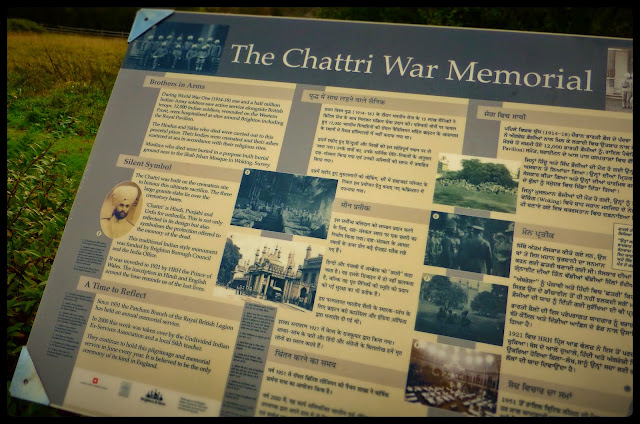Age shall not weary them, nor the years condemn:
At the going down of the sun and in the morning, we will remember them'
(a verse from 'For the Fallen' by Robert Laurence Binyon)
published in The Times newspaper on 21st September 1914
A time to reflect and remember the armed forces of the Commonwealth Nations who died in the line of duty during the First World War. We had therefore agreed that as a fitting tribute we would walk across the Downs and visit the Chattri Memorial.
During World War One (1914-18) 1.5 million Indian Army soldiers saw active service alongside British troops. 12,000 Indian Soldiers, wounded on the Western Front were hospitalised at sites around Brighton including the Royal Pavilion.
The Hindus and Sikhs who died were carried out to this peaceful site. Their bodies were cremated and their ashes scattered at sea in accordance with their religious rites.
It felt appropriate that we should arrive at the Chattri Memorial for 11.00am where we observed a 2 minute silence. A few others arrived at the Memorial and remained still and silent also. We looked at the names of soldiers and placed poppy crosses in the grass at the base of the stone.
There were 2 coloured pieces of material tied around the pillars at the front of the Chattri.
We slowly walked out from the enclosure and discovered some cross-country cyclists entering the site. We then noticed a lone sheep in the next field, so we made valiant attempts to play border collies and round her up and reunite the flock with her... however, she was having none of our persuasive hand gestures and took off in the opposite direction from where the gate was being held open.
We gave up after it sped away following another attempt.
We continued to walk north with the assistance of a southerly wind blowing across the channel courtesy of the French. The main track was muddy, but we managed to find adequate traction from the grassy edges and eventually marched on through gates that offered alternative routes. The path we were on was the East Sussex Border Path and we would soon be joining the South Downs Way and turning in an easterly direction.
The clouds were continuing to look threatening behind us, but remained confident that we would complete the circuit without the need for waterproofs.
The pace at times was something similar to how the armed forces would have been marching across muddy fields at the start of the First World War 100 years ago.
Heads down, we battled into the wind as we turned right again off the South Down Way and after a short uphill climb we headed down the hill, passing a herd of cows that looked emotionally detached from both the environment as well as each other.
As we descended the hill and cut our way along the foot of the valley, the shelter from the forceful wind had totally dropped. It felt like a different day, however the short glimpses of blue sky had been obscured by greying clouds.
The path weaved further along as hills to both our left and right continued to offer protection from the wind. Eventually we came to a lane and turned right, passing several farm buildings. Workmen were busily constructing flint-based wall sections.
For the next 15 minutes our direction became confused as whilst the footpath sign clearly demonstrated we could turn left, which was confirmed by the OS map, there was little indication that anyone had gone this way for 10 plus years before us.
The sign on a dilapidated gate politely asked we should 'please shut the gate'... however it must have been many many years ago since it was ever closed. We hesitantly considered our options and after passing several enclosures of Partridge and maybe pheasants also, we arrived at the edge of a field, with precious little options than to navigate our way around the edge of the field and walk the remainder of the way back to the car park along the lane.
Feeling frustrated at seeing the footpath disintegrate into impassable land, we trudged along the same lane we'd turned onto a half hour before to find several exits from which we would have emerged, had we gone a different way further up the hill.
The clouds were growing greyer and there was the first fine drizzle felt on our faces. By the time we arrived back to the cars, the rain was coming down rather more than the forecasters had proffered.
After some post walk calculations we discovered that what we thought was an excessively long walk of some 8-9 miles, turned out to have only put 7.3 miles on our milometer.










No comments:
Post a Comment